This victim of World War One’s most savage U-boat captain is on the deep side off North Cornwall but can enjoy hi-vis conditions, says JOHN LIDDIARD. Illustration by MAX ELLIS
TO ROUND OFF THE SUMMER, we’re back in the usually clear visibility of the north coast of Cornwall, out of Newquay towards Perranporth, for the WW1 wreck of the 2083-ton Spanish steamship Cristina.
With the wreck flattened close to the 40m seabed, the only good target for an echo-sounder are the Cristina’s two boilers, so this is where skipper Chris Lowe drops the shot and we begin (1).
Behind the boilers, the triple-expansion steam engine has fallen to starboard (2) to leave the bottom of the cylinders and connecting rods exposed.
Moving towards the starboard side of the wreck, the propeller-shaft (3) leads all the way to the stern. Alongside the shaft, the bearing blocks (4) stand on a reinforced section of keel.
Such a step in the main line of the wreck aft of the engine suggests to me that the torpedo from U55 struck just aft of the engine, and that the Cristina’s back was broken before the ship hit the seabed.
Continuing aft, the propshaft breaks again at a flanged joint (5), just before entering the stern gland.
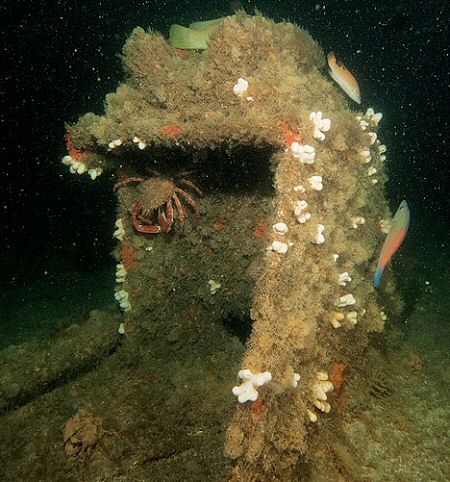
The remains of the stern show that it has fallen to port. The propeller is part-buried in the sand, with the rudder lying flat behind it (6). The bent rudder-shaft stretches out to port, with the steering quadrant at the top (7).
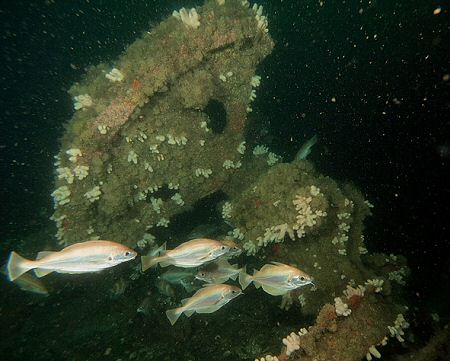
Further debris is scattered out to port, ending with a small hatch-coaming (8). Being a neutral Spanish ship, the Cristina did not carry a gun at the stern.
Now following the wreckage back forward, a single cargo-winch (9) marks the separation of the two aft holds. Next to this, the lower section of the aft mast has fallen to port. The upper part of the mast would have been wooden, and has now rotted away.
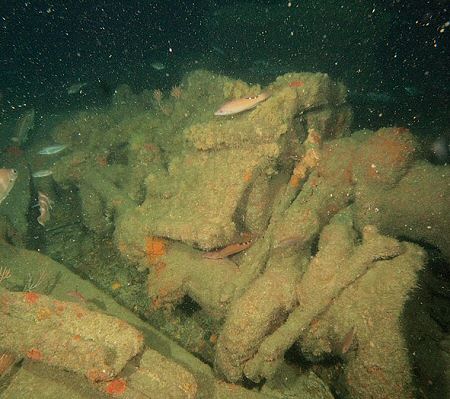
Almost straight out to port from the engine, the helm (10) also rests at the port extremity of the wreckage. This would originally have been located in a wheelhouse above the forward end of the boilers.
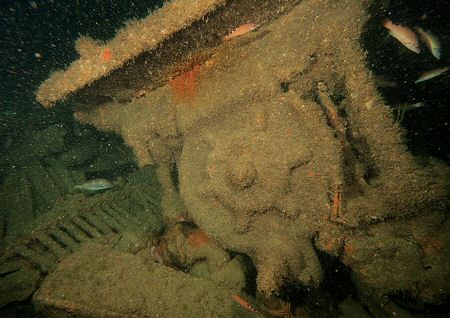
Staying to port, debris besides the boilers includes one of the boat derricks (11).
Forward of the boilers, a hull-plate from the starboard side of the ship rests across the wreck (12), with a section of railing poking out from below. A third, smaller donkey boiler (13) lies across the ship, just forward of the two main boilers.
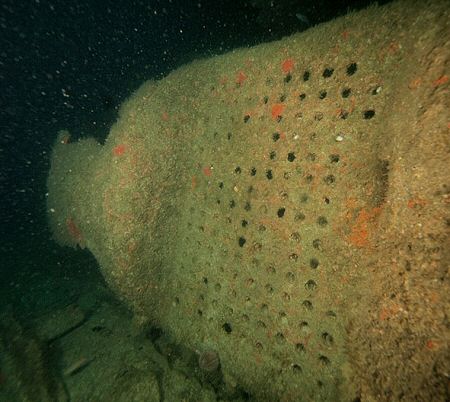
Over the forward part of the vessel, the distribution of wreckage is more obvious with the deck and sides of the hull having collapsed to port. Close to the section of rail, a small hatch-coaming (14) would have been above the bunker space for loading coal.
Again, there is only a single winch between the forward holds (15), this time upside-down. Running between South Wales and the north of Spain, with a coal cargo, most of the cargo-handling would have been by dockside machinery rather than the Cristina’s own winches. On the return journey from Bilbao, I suspect the usual cargo would have been iron ore.
The forward mast lies out to port, and aft from just forward of the winch. The base of the mast is still slotted through the reinforced ring of a deck-plate.
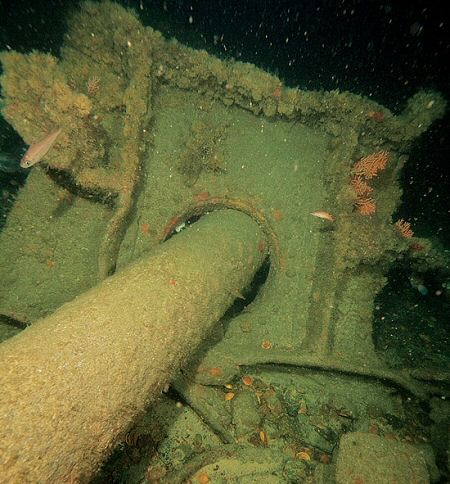
Just below the base of the mast are some metal bars stacked across the ship (16). Perhaps part of a cargo?
Now at the bow, the anchor-winch is broken, with one spindle lying next to a folded spare anchor (17). Next, a big pile of anchor-chain (18) marks the location of the chain-locker; then we meet the second spindle of the anchor-winch (19).
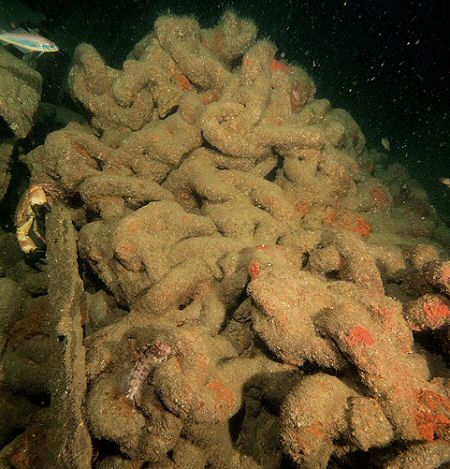
The bow is completely broken down to the seabed with no structure remaining, but the outline is still there. To the port side of the anchor-winch, a pair of bollards are tipped over on the sand.
Forward of these, the port anchor (20) is splayed out from the bow, the shaft still in the hawse-pipe. The starboard anchor (21) is similarly arranged, the shaft still in the broken hawse-pipe.
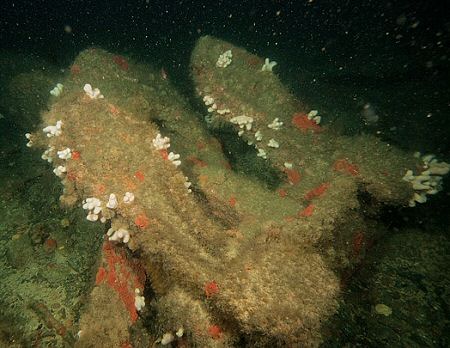
After a 40m rectangular profile, a fair amount of decompression will have been accumulated. With a large group, this may necessitate everyone returning to the shot and a decompression station.
THE KILLER CAPTAIN’S LAST TORPEDO
CRISTINA, steam collier. Built 1903, SUNK 1918
THIS 2083-TON SPANISH STEAMER WAS LAUNCHED IN CADIZ in 1903 as Kiora. This name was quickly changed to Cadiz II, registered at Bilbao. But though the name was soon changed again to Cristina, there were no other changes – she remained 282ft long, 40ft in the beam and drawing just 17ft, writes Kendall McDonald.
Her single screw was driven by a three-cylinder, 184hp triple-expansion engine with two boilers, all supplied by Central Marine Works of West Hartlepool.
Cristina was a neutral flying the Spanish flag after the war started, mainly carrying Welsh coal from Port Talbot to Bilbao. She lived a charmed life, somehow avoiding the U-boats, the commanders of which would not have hesitated to sink her on sight.
But her luck ran out 10 March, 1918, when she was on her way back to Bilbao and some 15 miles south-west of Trevose Head, North Cornwall. She ran straight across the bow of U55, which was also heading home and had a single torpedo left.
Kapitanleutnant Wilhelm Werner’s last torpedo hit Cristina in the starboard side. His U55 then dived steeply away to avoid Royal Navy craft hunting it and other U-boats in the area. Cristina’s crew had time to get to their boats, and were all picked up.
Werner, the most savage of all the U-boat commanders, deserved his title of “The Killer Captain”. He had earned his evil reputation by murdering survivors of the ships he sank.
He first appeared on the British List of War Criminals for sinking without warning the steamer Clearfield in October 1916.
Other victims followed, such as the liner Artist, the fishing smack Trevone, the petrol-carrier Saxon Briton (the survivors of which he uncharacteristically left unharmed), and the hospital ships Rewa and Guildford Castle.
With the steamer Torrington, Werner lined up 20 surviving members of the crew on the casing of his submarine and then dived, drowning them. He was believed to have killed other crews in the same way.
Werner was expected to be given a death sentence when his case came before the German Supreme Court in Leipzig in 1921, but the whole war-crime trial system collapsed in September of that year. Werner, the worst of all the U-boat war criminals, was never brought to trial.
U55 was given to Japan in the partition of the U-boats after it was surrendered.
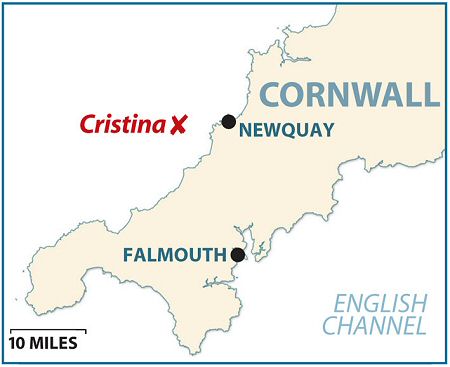
TOUR GUIDE
GETTING THERE: Follow the M5 to Exeter, then the A30 past Bodmin to Indian Queens, then turn north on the A392 to Newquay.
HOW TO FIND IT: GPS co-ordinates are 50 24.20N, 005 13.60W (degrees, minutes and decimals). The bow is to the west, and the wreck rises 4m from a 40m seabed at high water. Take note that this position is charted as an unknown, and be aware that the wreck at the charted position for the Cristina further inshore is actually a barge.
TIDES: In the big tides of North Cornwall, slack water is essential and occurs half an hour after high and low water Newquay, with the low-water slack being considerably shallower.
DIVING & AIR: Atlantic Diver, skipper Chris Lowe, 01637 850 930, www.atlanticdiver.co.uk. Nitrox, oxygen and trimix are available, but check in advance to make sure sufficient gas is in stock.
ACCOMMODATION: Chris Lowe can provide bunk-room accommodation. There are plenty of other options in Newquay.
QUALIFICATIONS: Suitable for PADI Rescue Diver, BSAC Diver Leader or equivalent. It’s the sort of dive where a side-mount of decompression gas would be advantageous.
LAUNCHING: Slip at Newquay.
FURTHER INFORMATION: Admiralty Chart 1149, Pendeen to Trevose Head. Ordnance Survey Map 200, Newquay, Bodmin and Surrounding Area. Shipwreck Index of the British Isles, Vol 1, by Richard and Bridget Larn. Dive The Isles of Scilly & North Cornwall, by Richard Larn and David McBride.
PROS: Typically good visibility makes this an easy dive for the depth.
CONS: A bit on the deep side for many divers.
DEPTH: 35-45m
Thanks to Chris Lowe.
Appeared in DIVER September 2010

